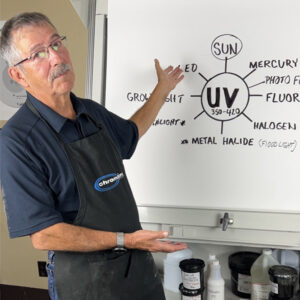
Exposure For Beginners: Understanding UV Light
When it comes to screen printing, one of the most critical steps is exposing your screens properly. A well-exposed screen can make a significant difference in the quality of your prints.
In the pursuit of saving costs, many beginners venture into DIY exposure units or purchase a secondhand unit. However, the choice of light source is often underestimated and can have a huge impact on the final results. In this post, we will break down the different types of lights commonly used for DIY screen exposure units and explain why some work better than others.
WATCH VIDEO: Will This Light Work? Screen Exposure For Beginners
Choosing the Right Light Source for DIY Screen Printing Exposure Units: A Comprehensive Guide
In the realm of screen printing, comprehending the nuances of UV light is paramount for achieving precise and consistent results in exposure units. UV energy, falling within the wavelength range of 350 to 420 NM, is the secret ingredient that cures emulsions, transforming screens into intricate stencils.
Various DIY light sources, from mercury vapor to LEDs, each come with their own set of challenges and advantages. While the temptation to save costs with makeshift exposure units is understandable, the intricacies of UV light, including its intensity and wavelength, make it a complex puzzle to solve without expert guidance. Investing in specialized equipment or consulting industry professionals not only guarantees accurate exposure but also elevates the quality and reliability of screen printing endeavors. Ultimately, understanding UV light ensures your screen making success.
1. Mercury Vapor Lights:
These lights emit a substantial amount of ultraviolet (UV) energy, ideal for exposing screens. However, they generate intense heat, posing a risk to both the screen and the user. Additionally, finding a specific wavelength range (350 to 420 NM) in hardware stores can be challenging, making them a less practical choice for DIY setups.
2. Photo Flood Lights:
These lights are widely available and emit some UV energy. However, the exact amount of UV emitted can vary significantly between different types of photo flood lights. Without proper information, it's challenging to ensure consistent and accurate exposure.
3. Fluorescent Lights:
Fluorescent lights have been traditionally used in the screen printing industry. They emit UV energy within the required wavelength range. However, generic fluorescent lights found in hardware stores may not provide the necessary UV intensity. Specialized fluorescent bulbs designed for screen exposure units are available but may require purchasing from specific distributors.
4. Halogen Lights:
Halogen lights are bright but produce minimal UV energy. They also generate a lot of heat, which can damage screens and pose safety hazards.
5. Metal Halide Lights:
While metal halide lights can emit significant UV energy, the ones commonly found in hardware stores might not be suitable for screen exposure due to the specific wavelength requirement. Professional-grade metal halide lamps are costly and require careful handling.
6. Grow Lights:
These lights are excellent for growing plants but might not provide enough UV energy for consistent and reliable screen exposure. They work better with diazo-based emulsions but are not ideal for exposure units.
7. Flashlights:
Flashlights are designed for visibility in the dark and are not intended for screen exposure. Even LED flashlights, while bright, may not emit the right UV wavelengths for accurate exposure.
8. LED Lights:
LEDs vary widely in terms of UV output. Some LED units are specifically designed for screen exposure and provide the necessary wavelength range (365 to 400 NM). However, finding the right LED source with the correct specifications is crucial.
9. The Sun:
In the realm of screen printing exposure units, the sun stands as the original source of ultraviolet (UV) energy. The sun emits abundant UV energy, making it a natural choice for exposing screens. However, its use comes with challenges. The sun's intensity varies based on factors like weather and time of day, leading to inconsistent exposure times. Additionally, controlling exposure duration becomes difficult, often resulting in overexposed or underexposed screens.
WATCH VIDEO: How To Expose Screens With The Sun
Quick Image and LTS 8012 Professional Exposure Units
While it might be tempting to create a DIY exposure unit, the risks and uncertainties associated with the choice of light source make it a challenging endeavor. Investing in a professionally made exposure unit might seem more expensive initially, but it ensures consistent results and saves money in the long run. Chromaline offers two different exposure units, the Quick Image (available in two sizes) and Laser-To-Screen (available in three sizes).
WATCH VIDEO: Automated Screen Exposure With The LTS 8012
WATCH VIDEO: Quick Image Exposure Unit Overview
Contact Chromaline Today
If you are unsure about which light source to use, consulting with industry experts or manufacturers like Chromaline can provide valuable guidance tailored to your specific needs. Remember, the key factor is the UV energy within the 350 to 420 NM wavelength range. Without it, achieving accurate and reliable screen exposure will remain a daunting task.
Chromaline's line of premium screen printing emulsions and products stands out as the top choice for screen printers seeking exceptional results. If you have any further questions about understanding UV light for screen exposure or any of our Chromaline screen printing products, please contact us today.

